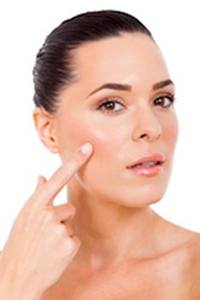A number of changes happen to your face as you age. Some are more obvious, like wrinkles or a loss of firmness to your skin. Others are less obvious, including a receding of the facial bones. When this occurs, your face loses definition in the chin, jaw, and cheek, resulting in a flatter look. Dr. Todd Hobgood restores or enhances cheek definition through cheek augmentation with implants or dermal fillers at his practice in the Scottsdale-Phoenix area.
How Implants Work
Implants come in a wide variety of materials and are chosen based on their intended destination. Cheek implants are usually soft and semi-solid to mimic the actual cheek. The most common material used in cheek implants is silicone, but they can also be constructed out of other materials, such as Gore-Tex.
Cheek implants also come in three different sizes designed for different areas depending on the nature of the problem. Malar implants are the most common type and are placed right on the cheekbone. These implants give the cheekbone a higher and more contoured appearance. Submalar implants are placed below the cheek bone to give the cheek a fuller look. This is usually used to correct a sunken or gaunt appearance in the midface. Tear trough implants are the third type of implant and are place beneath the eyes to correct a hollow or sunken eye look.
Malar and submalar implants are usually inserted through incisions in the mouth. Once the incision is made, the surgeon will insert and move the implant into place, then ensure that the shape and placement are correct before closing the incisions. Tear trough implants can also be placed through the mouth, but they are usually placed through incisions in the lower eyelid. By making internal incisions, the surgeon prevents any external scarring on the face.
Recovery from implant surgery is pretty mild compared with other facial plastic surgery procedures. There will be some swelling and tenderness around the cheek and incision site, but this will go away after a few weeks.
How Dermal Fillers Work
If you aren’t wild about using permanent implants to augment your cheeks, there are several dermal fillers available that can accomplish the same result. Dermal fillers are one of the most popular non-surgical procedures available to patients today and Dr. Hobgood utilizes them frequently in his practice.
Some fillers work better for certain types of procedures than others, and cheek augmentation is no different. Radiesse, Juvederm, and Restylan are three possible choices for adding volume to the face. These fillers contain calcium hyroxilapatite, which is a fancy name for really tiny pieces of calcium. The calcium hyroxilapatite acts like a liquid implant when injected into a specific area, giving your cheek a fuller appearance without requiring surgery.
Which One Is Best?
Choosing between getting implants and fillers is a decision that will have to come from you and your doctor. Each patient is different and some patients will benefit more from one option than from another. Your doctor will examine you during your consultation and discuss your goals before determining the best option for you.
There are a few key differences between implants and dermal fillers. The first is that fillers are not permanent. Patients have to get new treatments about once a year for as long as they wish to have them. Fillers are also less expensive than implant surgery. The average facial implant surgery runs about $4,250, while each treatment of Radiesse costs about $635. Facial implants require more recovery time than fillers. A dermal filler can be applied in about 20-30 minutes and you can go right back to your normal routine with zero down time. That being said, cheek implants do have a mild recovery and won’t be as extensive as other types of facial surgery. Your choice will depend on what your surgeon thinks will be best for you as well as your own personal preference.
Cheek Augmentation From Dr. Hobgood
Dr. Todd Hobgood has been a plastic surgeon for over 10 years and is well-known among his patients for his expertise and compassion. He is double board certified with the American Board of Facial Plastic and Reconstructive Surgeons and the American Board of Otolaryngology-Head and Neck Surgeons. Dr. Hobgood and his practice staff want you to have the best possible experience with your procedure and are committed to your care and safety.
If you would like to schedule a consultation with Dr. Hobgood, call his office in Scottsdale, AZ, at (480) 214-9955 or send him an email through his Patient Contact Page to make an appointment.


Leave a Reply